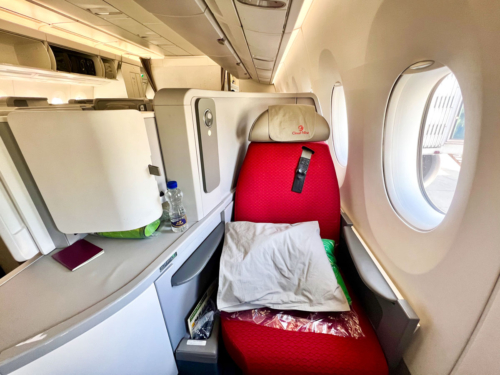Premium economy and more flights to London? I interview Ethiopian Airlines CEO Mesfin Tasew
Links on Head for Points may support the site by paying a commission. See here for all partner links.
On Wednesday evening, Ethiopian Airlines hosted a party to celebrate 50 years of flying to the UK. It was a big event: guests included the UK ambassador to Ethiopia and vice versa, as well as Ethiopian Airlines partners such as Airbus, Rolls Royce, Heathrow Airport and more.
The airline has a lot to celebrate: since 2005 it has successfully implemented a number of strategic growth plans and is now the largest airline in Africa, having overtaken rivals such as South African Airways and EGYPTAIR in 2019. It is also one of the few African airlines to regularly turn a profit, despite heavy investment to support an average growth rate of 25% before the pandemic.
It isn’t just a success by African standards. A lot of airlines would love to book a $937 million profit like Ethiopian Airlines did last year.

Of course, attention on the night was focussed on the air bridge between Ethiopia and the UK, which began with a Boeing720-B service (photo below!) from London twice a week in April 1973 operating via Cairo, Rome and Frankfurt.
In the intervening years this has grown to a daily A350 service from Heathrow to Addis as well as a five-weekly one-stop operation from Manchester to Addis via Geneva, with connections from Addis all over Africa and the rest of the world.
To discuss what lies in Ethiopian Airlines’ future, I sat down with Group CEO Mesfin Tasew. Mesfin has been working at Ethiopian Airlines since 1984 and became CEO in March 2022.
The airline website is here if you want to learn more.
The future of fifth freedom routes
Unusually for a carrier of its stature, Ethiopian Airlines operates a number of what are called ‘fifth freedom’ routes. These are routes with intermediate stops where passengers can choose to begin or end their journey.
Ethiopian Airline’s flights from Manchester are a prime example, as these operate with a stop in Geneva where you can choose to get off. In fact, that’s exactly what I did last year, when the airline introduced the route. Whilst the majority of passengers continued on to Addis Ababa, I ended my journey in Geneva before returning home to London.
Typically, fifth freedom flying rights are hard to get as you need the approval of a third party country in order to be able to sell tickets between the two destinations. However, it does allow airlines to fill larger aircraft with feeder traffic from a wider network of destinations.
“On several routes, we fly point to point …. But there are others where we see opportunities for fifth freedom traffic. And whenever we see that, we take the opportunity to do so. So today, we operate both and in the future, we’ll continue both, depending on the market.”
More services to Europe, including London
I asked Mesfin if we can expect any more services into Europe or the UK:
“We have plans to fly to more cities in Europe, and we’re looking at Madrid, Lisbon, Amsterdam and also Gatwick at the moment.
So we are looking at these four stations in Europe so we can continue expanding our network.”
London is a particularly strong route for Ethiopian Airlines, so it’s no surprise that Mesfin wants to increase services here.
“Prior to COVID we used to have three more flights per week to Heathrow; we used to have ten weekly flights from London but now we’re limited to seven. In the short term we’re hopeful that we will restore our pre-pandemic frequency of ten and eventually increase to double daily.”
Whether that is possible will come down to Heathrow. The airline may have to split operations across airports as carriers such as jetBlue have done in recent years.
“Heathrow is our preferred option. The current plan is to increase frequency to London Heathrow Airport. If we cannot do that then we will go to Gatwick.”
New airplanes and a new airport
Of course, you can’t launch new routes without more aircraft:
“Ethiopian Airlines is growing, continuously growing. We are expanding our network, which implies that we need more airplanes. Today we have 143 aircraft, but we also have twenty seven aircraft on order which we are going to receive in the coming three years.
We have a fleet plan for the next twelve years and that shows how many airplanes of each size we need. We are evaluating the options available and as soon as we finalise our plan will place orders for new aircraft.
That will include narrow-bodies and wide-bodies. When we say wide-body we have 300-seaters as well as 350-400 seaters that will depend upon our assessment of the market and the service we want to deploy. So that is currently going on and we hope to finalise that before the end of this year.”
The airline’s growth plans require it to almost double its fleet to 271, although Mesfin wouldn’t reveal the ration of wide-body to narrow-body aircraft he expects to have.
“There are opportunities to fly long-range narrow-body aircraft where there is smaller capacity. And the Boeing 757 aircraft was in that category and we were happy with that aircraft. We have been telling the aircraft manufacturers to come up with a replacement for the Boeing 757 aircraft, but unfortunately that hasn’t happened.”
Could the A321neo, with its two extended-range versions, be on the cards?
“It doesn’t exactly replace the 757, but it enhances performance range capability of the A320 family. We will evaluate it. And depending on the market condition we will decide.”
Ethiopian Airlines won’t just need more planes to fulfill its growth plans. It will also require a bigger airport.
Currently, Addis Ababa Bole Airport has a maximum capacity of 25 million passengers per year, which Ethiopian expects to hit in around five years. Work has already begun on developing a new, bigger airport.
“We have established the need to build a new airport, and we have identified a location. Now we’re in the process of securing the land. As soon as we complete that, we’ll select a contractor, financing and we’ll start the construction work.
The new airport will have a capacity of 100 million passengers per year. So that’s a huge increase and will support our aspirational target to carry 60 million passengers by 2035.”
Inside the cabin
Premium economy has become an increasingly competitive cabin since Virgin Atlantic and EVA Air first introduced it in 1991. Despite its success – Lufthansa considers it its most profitable cabin per square foot, and Emirates CEO Tim Clark said he was shocked by demand when it recently launched – many airlines still haven’t introduced it.
“So far, our cabin configuration is business and economy only, but a lot of customers have been requesting that we introduce premium economy. So we have initiated a new project to conduct detailed studies on that, we are seriously looking.
Selection of seats will not will not take long. The integration work takes longer, and introducing this throughout our fleet will take a longer time and we’ll be doing it in phases. Again, the decision on this will be made before December, hopefully.”
Changes are also coming to business class, with the potential for refurbishment program to create a consistent and unified experience across Ethiopian’s wide-body fleet.
“You know, when we first introduced the early 787s and 777s the choice we had at the time was is installed on them today. But during the last few years we have seen opportunities to introduce seat configurations that better meet the needs of our customers. So we have introduced a 1-2-1 configuration in business class on our newer 787 and A350 aircraft that we received during the last two years, three years. Now we have a plan to replace the older cabin with the new one. We are evaluating.”
Any upgrade to Ethiopian’s older aircraft, including the 777 with its dated 2-3-2 configuration is welcome.
“We have already decided on some. For example, for the oldest 787, we have decided to introduce the new configuration, but Boeing is not ready to give us the integration work. They’re saying it could take up to two years.”
Conclusion
So far Ethiopian Airlines has succeeded where so many airlines fail – growing sustainably and profitably.
The focus will be on whether it can continue to do so, serving a growing African demand for air travel as well as connecting intercontinental passengers to destinations in Africa and beyond.
It’s great to hear how successful the UK is for the airline and it will be interesting to see where – and when – Ethopian grows its London presence.
If this interview has piqued your interest, you can also read my review of ‘Cloud 9’ business class on Ethiopian Airlines as well as my review of the ‘Cloud 9’ lounge in Addis Ababa and the Star Alliance Gold lounge next door.
You can find out more about Ethiopian Airlines on its website here.
Thank you to Mesfin and his team for their time.
PS. If you are not a regular Head for Points visitor, why not sign up for our FREE weekly or daily newsletters? They are full of the latest Avios, airline, hotel and credit card points news and will help you travel better. To join our 70,000 free subscribers, click the button below or visit this page of the site to find out more. Thank you.

How to earn Star Alliance miles from UK credit cards (July 2025)
None of the Star Alliance airlines currently have a UK credit card.
There is, however, still a way to earn Star Alliance miles from a UK credit card.
The route is via Marriott Bonvoy. Marriott Bonvoy hotel loyalty points convert to over 40 airlines at the rate of 3:1.
The best way to earn Marriott Bonvoy points is via the official Marriott Bonvoy American Express Card. It comes with 20,000 points for signing up and 2 points for every £1 you spend. At 2 Bonvoy points per £1, you are earning (at 3:1) 0.66 airline miles per £1 spent on the card.
SPECIAL OFFER: Until 15th July 2025, the sign-up bonus on the Marriott Bonvoy American Express Card is TRIPLED to 60,000 Marriott Bonvoy points. This would convert into 25,000 Avios or into 40 other airline schemes. It would also get you at least £300 of Marriott hotel stays based on our 0.5p per point low-end valuation. Other T&C apply and remain unchanged. Click here for our full card review and click here to apply.
There is a preferential conversion rate to United Airlines – which is a Star Alliance member – of 2 : 1 if you convert 60,000 Bonvoy points at once.
The Star Alliance members which are Marriott Bonvoy transfer partners are: Aegean, Air Canada, Air China, Air New Zealand, ANA, Asiana Airlines, Avianca, Copa Airlines, Singapore Airlines, TAP Air Portugal, Thai Airways, Turkish Airlines and United Airlines.
You can apply here.

Marriott Bonvoy American Express Card
60,000 points (to 15th July) and 15 elite night credits each year Read our full review








 Rhys
Rhys 





Comments (28)